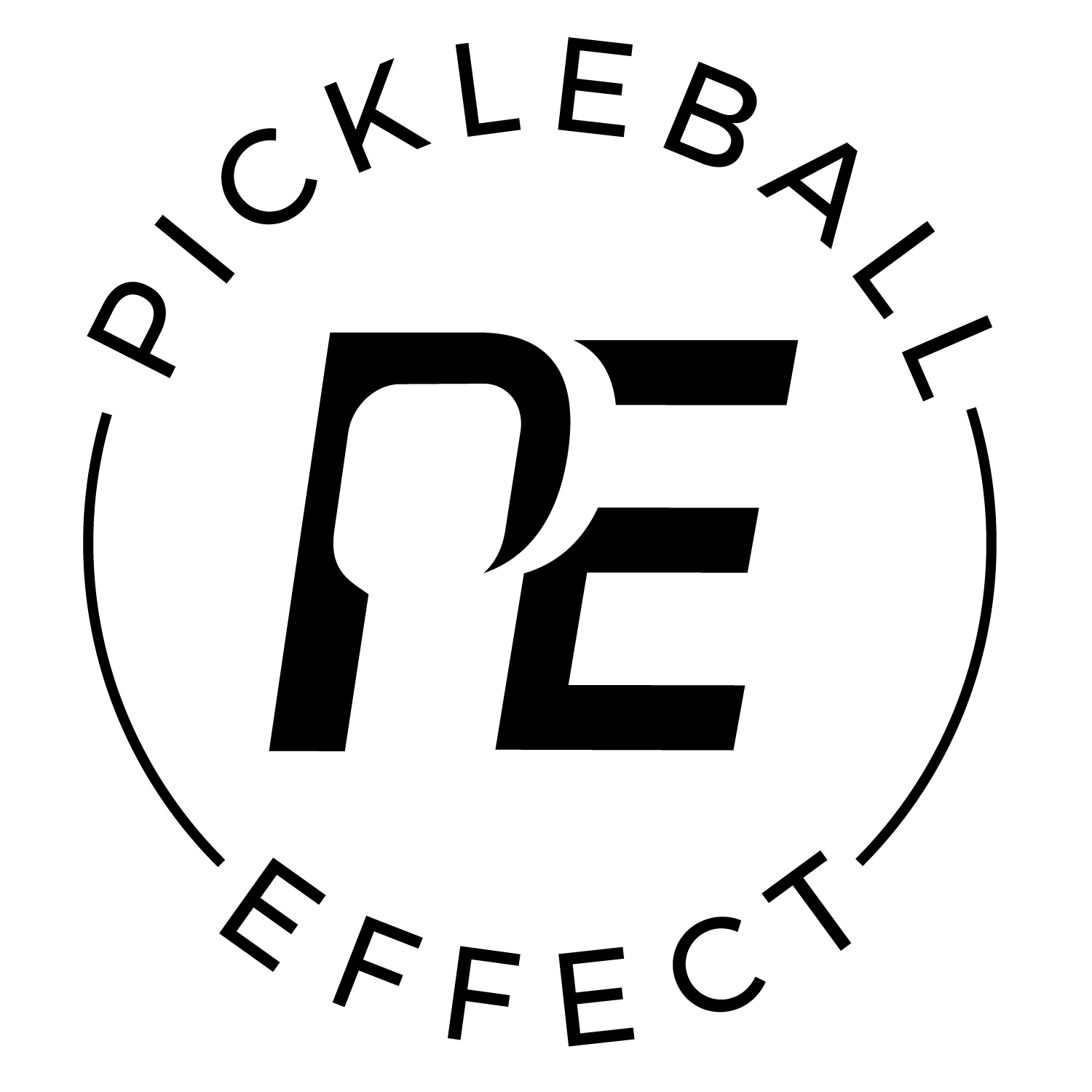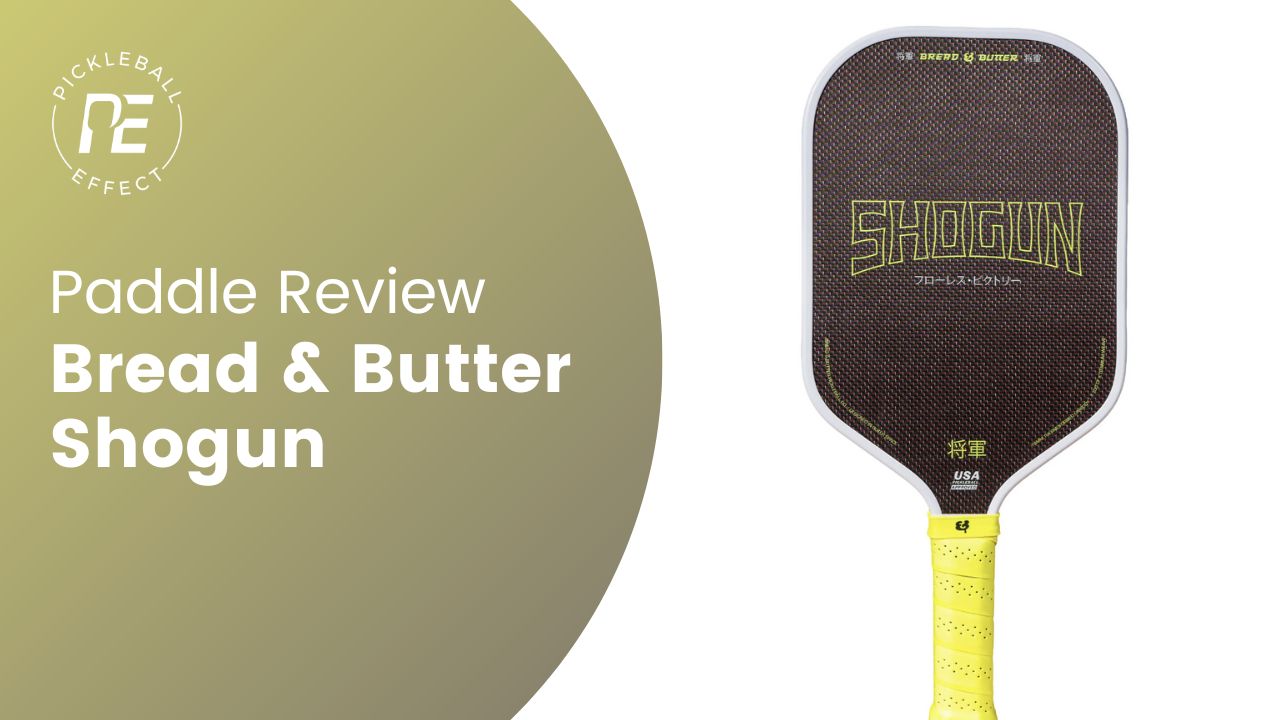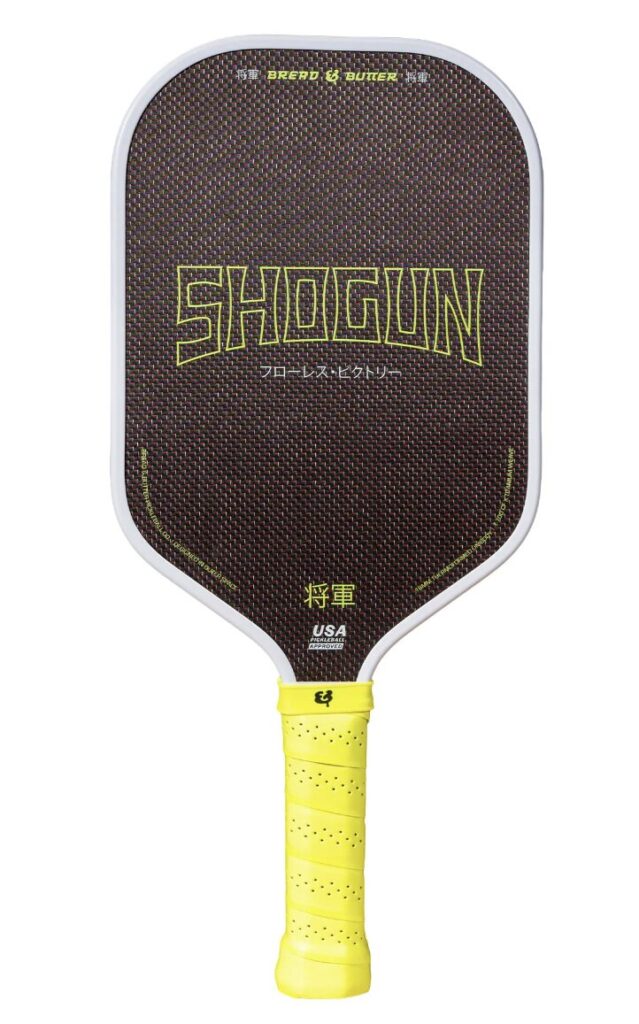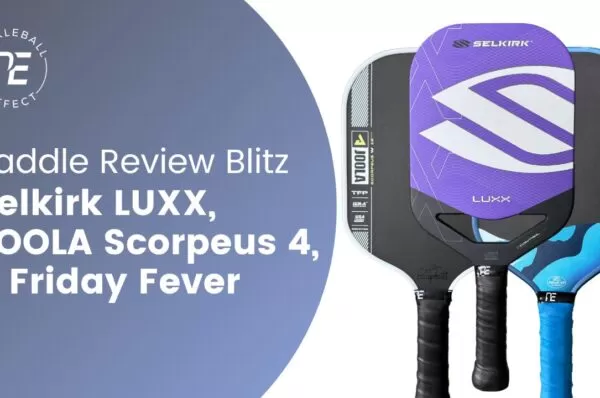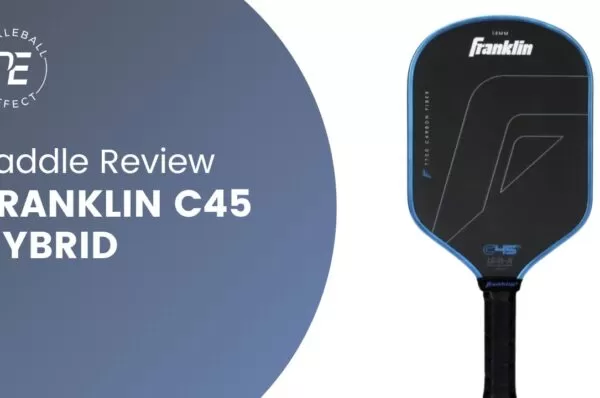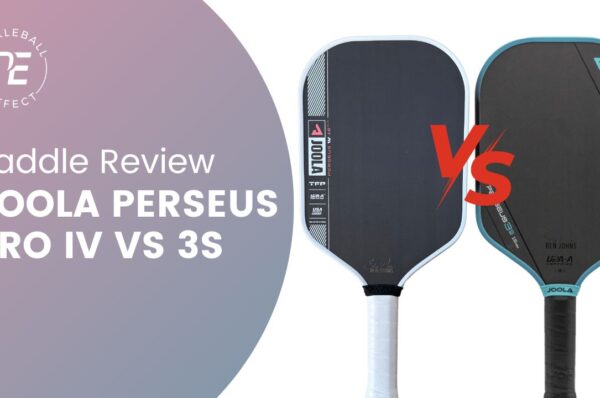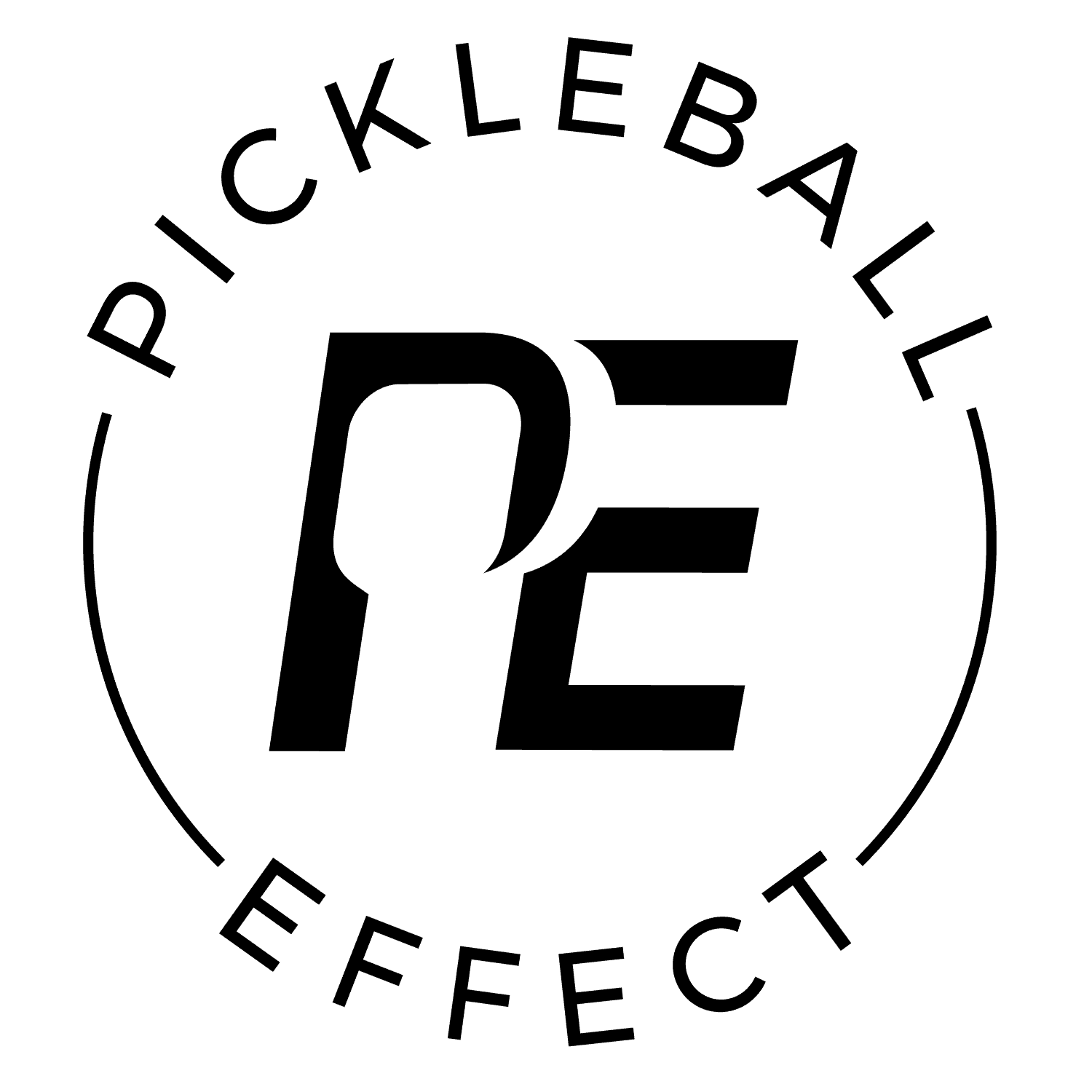Bread & Butter’s brand has a big personality and is recognized for their captivating marketing content. While their performance paddles have been well-received and are competitive in the market, the brand has not been seen as particularly innovative and is known by some as only an Instagram brand. However, the recent release of the Shogun paddle, incorporating titanium as a facing material, is a first of its kind and it’s good. Although their marketing remains lively, Bread & Butter is expanding its reputation beyond being solely an Instagram-focused brand and have found something special with its titanium faced Shogun.
After drilling and playing with the Shogun, here’s my review on its performance.
Table of Contents
Paddle Stats & Tech
B&B Shogun
- Static Weight: 8 oz avg
- Swingweight: 119-122 (high)
- Twistweight: 6.1-6.2 (moderately low)
- Spin RPMs: 1928 (high)
- Length x Width: 16.5″ x 7.375″ (elongated)
- Face: Titanium/Carbon Fiber Weave
- Grip Circumference: 4.25″
- Handle Length: 5.5″
- Core: 16mm Polypropylene Honeycomb, Foam Walls
- Special Features: Thermoformed
- Paddle Type: All-court
- Price: $189.99 ($162 with code 15EFFECT)
- Warranty: 30 day love it or return it policy and a six month warranty
(Get 15% off with the discount code 15EFFECT directly on their website)
Performance Summary
Thermoformed style paddles gained popularity in early 2023 by offering an all-court style of play that was better than anything else yet created. The one performance drawback to thermoformed style paddles has always been that they have a stiffer or harsher feel to them. Although many players have grown accustomed to this characteristic, revisiting a non-thermoformed control style paddle serves as a reminder of how effortlessly one can connect with the softer, plush feel it provides.
Wouldn’t it be nice if a thermoformed paddle had the softer, plusher feel of a control paddle but played with the power of an all-court paddle? Well, that’s what Bread & Butter created by incorporating titanium/carbon fiber weaved face. The Shogun plays with the power you expect from a thermoformed paddle but you get a softer, more pleasant impact feel that all-court style thermoformed paddles didn’t have before. As a result, you get the offensive ability of an all-court paddle combined with a more intuitive feel that is typically only associated with control type paddles.
I will say that I’ve hit other thermoformed paddles that also have a soft feel to them, like the Bread & Butter Loco for example, but those paddles didn’t retain the all-court characteristics that stiffer thermoformed paddles have and fall into the control category. The Shogun is the first thermoformed paddle I’ve played that feels softer like this and keeps its nice balance of control and power that characterizes paddles in the all-court category. While the paddle feels softer like a control paddle, it’s a bit springier and more responsive in comparison to them. It’s not as muted. It’s a unique sensation that I think a lot of people will like. I bet we see a lot more titanium faced paddles start rolling in the second half of the year.
Outside of the feel of the paddle, it plays very similar to their Filth model which means it has average forgiveness for an elongated shape and is a little on the heavier side of things. Spin wise, it gave me a good result with an average of 1928 RPMs in my spin tests.
Other Thoughts
The presentation and packaging of the Shogun and all of Bread & Butter’s paddles is top notch. There are only a handful of brands that put as much attention to the packaging and experience you have when receiving the paddle as Bread & Butter. It’s exciting when it comes in the mail and it’s fun to open the customized Shogun box and find the extra goodies they leave in there for you along with the paddle.
I also have their Shogun shirt and it’s very comfortable and fun too. You might want to pick one of those up with the Shogun as well!
My Recommendation
For those that like or play with Bread & Butter’s Filth model then the Shogun is a no brainer. If you’re coming from other similar shaped and weighted paddles like the CRBN 1X or the Vatic Pro V7 then I bet you like the Shogun more. But, if you’re coming from a hybrid or standard shaped paddle then the heavier elongated design of this paddle will most likely be uncomfortable. Also, note that if you are coming from the Filth, the grip circumference of the Shogun is a little bigger.
I imagine Bread & Butter will introduce the titanium face to their Loco shape down the line but right now you only get the one shape and weight option and if that isn’t for you then you have to wait until more options come out.
(Get 15% off with the discount code 15EFFECT directly on their website.
Braydon competes at the 5.0 level and plays in 5-10 tournaments a year. He plays/drills 3 to 4 times a week and would play more if time allowed it.

Paddle Terms Glossary
We’ve categorized paddles into three categories. Control, All-Court, and Power. Paddle categories are determined by Braydon after he hits or reviews the paddle.
- Control paddles offer a softer feel and better absorbs pace off the ball but doesn’t give you as much power.
- All-Court paddles give you a blend of power and control and does well at everything though it doesn’t excel at anything.
- Power paddles often have a firmer feel and will return more power but are harder to control.
A paddle’s weight represents the inherent mass of the paddle as measured on a scale. However, relying solely on this static weight measurement can be misleading when assessing the true perceived heaviness of the paddle. Even if two paddles both clock in at 8 oz, their actual heft in your hand can markedly differ due to variations in weight distribution within the paddle. This is why the static weight should be considered with the swingweight of the paddle. See the definition of swingweight below.
The weight value listed in the database corresponds to the paddle’s weight that I used to gather the swingweight and twistweight measurement. It’s possible that if your paddle has a different static weight than then the swingweight and twistweight may be slightly different.
There are three primary shapes a paddle can have which consists of the length and width of the paddle. These three shapes are:
- Elongated: The dimensions for an elongated paddle are 16.5″ x 7.5″.
- Standard: A standard shaped paddle has dimensions of 16″ x 8″.
- Hybrid: A hybrid shaped paddle falls somewhere in between the standard and elongated shapes, with approximate dimensions of 16.25″ x 7.5″-7.7″.
Then there are two less common shapes you’ll see. These are:
- Extra-Elongated: This shape is 17″ x 7″
- Widebody: This any paddle shorter than 16″ long.
When considering the advantages and trade-offs of paddle shapes, it’s important to understand the characteristics of each shape.
- Elongated Paddle: An elongated paddle offers increased reach, spin, and power. However, this additional reach comes at the expense of forgiveness, particularly from side-to-side.
- Standard Paddle: In contrast, a standard-shaped paddle provides less reach and a little less power & spin but offers greater overall forgiveness. This means that while you may not have the same extended reach as an elongated paddle, you gain better control and stability.
- Hybrid Paddle: The hybrid shape serves as a middle ground between the elongated and standard shapes. It provides a balance between reach and forgiveness, offering players a versatile option that combines aspects of both shapes.
It’s interesting to note that advanced players often prefer elongated shapes. On the other hand, players at lower skill levels typically opt for the extra forgiveness offered by standard shaped paddles.
Ultimately, the choice of paddle shape depends on an individual’s playing style, preferences, and skill level. Whether your focus is on reach or forgiveness, understanding the unique benefits and trade-offs of each shape can assist you in selecting the paddle that best suits your game.
Swingweight is a measure of the paddle’s resistance to swinging about the end of the handle. The higher the swingweight number the heavier it will feel in your hands. A higher swingweight has more power but is harder to swing, lower swingweight is easier to swing but has less power. Sometimes a faster swing with a lower swingweight can make up for power lost in swingweight. The price paid for that is greater impact shock. Stock swingweights will vary between 100 – 140.
Twistweight is the resistance to rotating around the long axis through the middle of the paddle from butt to tip. The higher the twistweight the more resistance the paddle has to rotating on off center hits. This measurement is closely related to the amount of forgiveness or the size of the sweet spot of the paddle. A higher twistweight indicates a bigger sweet spot. Twistweight numbers range from 5 – 8.
Measuring the revolutions per minute (RPMs) off of a serve you get a number that shows the spin potential of a paddle. Using these RPM measurements I’ve created five buckets that a paddle will fall into indicating its overall spin potential. The five buckets are:
1900 or Higher = Very High
1700 – 1900 = High
1500 – 1700 = Medium
1300 – 1500 = Low
1300 or less = Very Low
You can tell a big difference in the amount of spin a paddle generates when you compare a Very High paddle to a low paddle. But the gains from Medium to High to Very High are marginal. We’ve found that having at least a medium rating is often enough if you’re looking for a good spin paddle. However, if you’re a big hitter then you will benefit more from a high spin paddle to help you keep the ball in play more often.
The power level of a paddle is shown in miles per hour (MPH) after taking ten measurements with a speed gun of hitting a serve as hard as I can. This measurement gives you an idea of how hard you can hit the ball when given the chance to take a full swing. So shots like serves, drives and overheads. The higher the MPH reading the more power you can generate with the paddle.
I also show the percentile ranking of the measurement to give you an idea of how it stacks up against the rest of the paddles in my database.
The pop level of a paddle is shown in miles per hour (MPH) after taking the average of ten speed gun measurements of hitting a punch volley as hard as I can. This measurement gives you an idea of how hard you can hit the ball on shorter swings and gives you an idea of how quickly a ball comes off the face when you apply less force on the ball. So shots volleys, dinks, counters, and resets are all affected by the pop measurement. The higher the pop measurement the stronger your counters will be but it takes more skill to keep the ball from floating or popping up on you when resetting a hard hit ball or when dinking.
I also show the percentile ranking of the measurement to give you an idea of how it stacks up against the rest of the paddles in my database.
The term “forgiveness” pertains to both the size of the sweet spot and the stability of the paddle. A paddle that is more forgiving offers a larger sweet spot, greater stability, and yields more power when hitting off-center shots. On the other hand, a less forgiving paddle has a smaller sweet spot and does not provide as much power when hitting off-center shots.
While there seems to be only benefits of more forgiving paddles, less forgiving paddles are often more maneuverable and is easier to generate more paddle speed.
